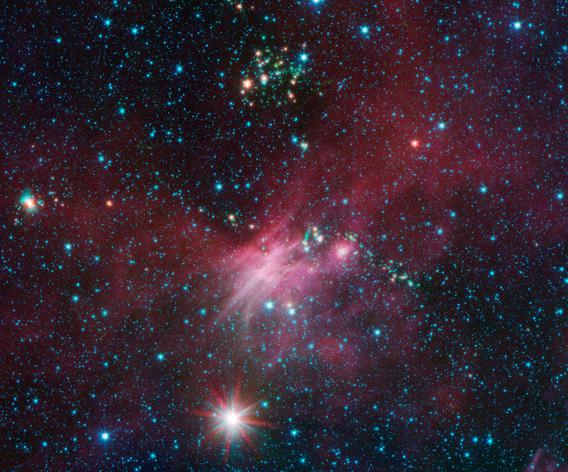Spitzer Space Telescope is one of NASA’s flagship astronomical observatories, peering into the Universe in the infrared. It ran out of coolant in 2009, losing some of its infrared capabilities, but it still takes wonderful data in two other colors of IR that are useful for mapping the galaxy.
Our Milky Way galaxy is a vast, flat disk, and astronomers are using Spitzer to take images of that disk in a 360-degree panoramic survey to be released later this year (in the clearly artificially acronymed Galactic Legacy Infrared Mid-Plane Survey Extraordinaire—Glimpse 360). However, they just released pictures of a few small regions that show the telescope is still doing a great job.
Looking toward the constellation of Canis Majoris, near Orion, they spotted an area where stars are being born, and it’s lovely:

All photos by NASA/JPL-Caltech/University of Wisconsin
In these images, the green and blue colors are from Spitzer, and red is from observation by WISE, another IR mission that ended in 2011. The red comes mostly from long, complex chains of organic (carbon-based) molecules called polycyclic aromatic hydrocarbons, or PAHs. They are formed when stars are born and when they die. Green is gas, and blue is from older stars. Young stars appear more reddish-yellow, because they’re still encased in the thick shroud of dust in which they were born.
Not only is that pretty, but when you look at it in detail, you see that several of the stars have jets of matter blasting away from them, like in this part:

Human babies do this too.
Some of the stars have gas blowing away from them in opposite directions. The detailed physics of this is complex, but young stars blast away gas as they form. A swirling disk of material around a young star can focus that outflow from an expanding sphere into two conical beams going out from the poles of the disk. In the images you can see these beams as short, stubby green fingers pointing in opposite directions away from the star. (I’ve marked a couple with arrows. Don’t confuse them with the sharp spikes every star has; that has to do with the internal optics of the telescopes.)
Here is another part of the image:
They’re not easy to spot, but if you look closely, you can see a few. The curved backward-comma one in the upper left is the most obvious.

This may be a young star beginning to shed its cocoon of gas and dust.
I was also intrigued by the object inset here; the gas around it appears to be fuzzy, unlike the jets, but still on opposite ends of the star. I’m not clear what this is, but I suspect it’s a slightly older (though still infant) star, breaking free of its cocoon. Such bipolar structures are sometimes seen in these situations.
More images and descriptions are available in the Spitzer release about the Glimpse survey. These are clearly just a taste of what’s to come in the survey later this year. As an astronomer I’m delighted at the science that will come out of this, and as a human I am awed by the beauty. It’s the best of both—of all—worlds.